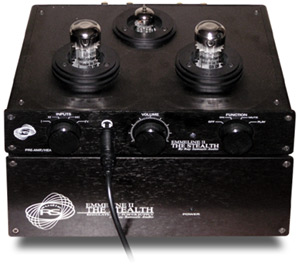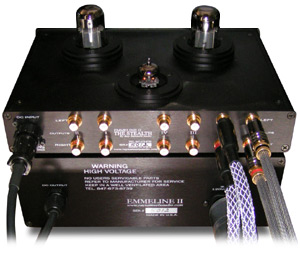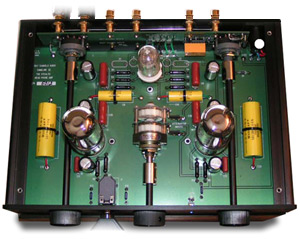![[SoundStage!]](../sslogo3.gif) All In Your Head All In Your HeadBack-Issue Article |
|
June 2004 Ray Samuels Audio Emmeline II The Stealth Preamp/Headphone Amp
A good friend of mine recently decided to buy a preamp/headphone amp, and he was nice enough to send it to me so I could hear it -- even before he did. That's friendship. The preamp/amp he bought, The Stealth, is designed and built by Ray Samuels Audio. After two successful solid-state headphone amps, the $875 USD HR-2 and the $495 portable XP-7, Samuels decided to build a tube-based preamp/headphone amp. He wanted to build a preamp that would defeat the Goliaths of the preamp world and provide headphone functionality. The $2495 Stealth was designed with the express purpose of eliminating the dependency on expensive NOS tubes. It is built to sound great using Electro-Harmonix tubes, and so uses two 6SN7s and one 12AX7. You can retube the amp for under $40, making it an outright bargain to buy and try different tubes in order to find just the sound you’re seeking. Sadly, one day the supply of NOS tubes will run dry, and when that day arrives we’ll all be thankful for amps that were made to sound great using inexpensive, current-production tubes. The Stealth is a well-built, compact unit. The build quality, Samuel’s attention to detail, and assembly are all impeccable. This all shows when you open the amp and take a look inside. It inspires confidence -- you see just how well the soldering and parts layout are done.
The Stealth has a four-position rotary power switch. The first position is Off, and the second is On, which only applies voltage to the heater filaments to warm the tubes. The third is Mute, which applies the high voltages to the tubes, yet mutes the input. The last position is Play, and it applies the signal to the tubes for amplification. The various positions allow for a gentler power-up of the tubes, resulting in longer tube life. When the tubes are cold you should switch the selector to On for one or two minutes to warm the tubes. Then switch to Mute to apply the high voltages for about 30 seconds. Finally, switch to Play and away you go. Patience pays off with tubes, so give them time to properly warm up before your listening sessions. To feed The Stealth, I used an eXemplar Audio-modified Denon DVD-2900 universal player and an Electrocompaniet EMC-1 Up 24/192 CD player. I used ZCable Live v5 and Jaden Pursang. To provide juice, I used Virtual Dynamics Master and Nite power cords. To listen to all this equipment, I used the Sennheiser HD 600, Beyerdynamic DT880, Sony CD3000, or Grado SR325 headphones. The Stealth is one of those products that can make life difficult for an audio writer. Nothing jumps out and screams deficiency, no matter which headphones are used. It was simply a joy to listen to with whatever headphones were on my head at the time. Even those considered harsh by some users sounded wonderful over the Stealth. Nothing is one of the first things you’ll notice about this amp. Whenever the music diminishes, pauses, or ends, you’ll hear nothing but blackness uninterrupted by the noise often associated with tube headphone amps. The Stealth is dead silent, and the only time you can get any noise out of it is when you turn it all the way up. Doing so will reward you with little more than a slight hiss; just don’t hit the play button on your CD player when the volume is this high. After countless listening sessions I came to the conclusion that The Stealth has a blend of solid-state characteristics, such as speed and detail, and a slight hint of tube lushness. This makes for enjoyable and exciting listening. The Stealth is not in any way polite. It is capable of getting down and rocking with the best of them. Unlike lesser amps, The Stealth is not meant for playing one kind of music. Scratch that -- it is meant for playing one kind of music: the kind you want to hear played well. While listening to Elton John's Goodbye Yellow Brick Road [Polydor 821747], I realized for the first time that the drums often sound like a really cheap electronic drum set you would give to a child. They sound horrible , and the Stealth passed their sound right to the headphones. For testing bass nuance I have never found a recording even close to that of 100 Portraits and Waterdeep’s Enter the Worship Circle [no catalog number]. These guys use a lot of percussion instruments, many of which I have never heard of before. Djembe, bombo, dumbeks, tongue drum, kanjira, tabala, dholak, and even a cookie sheet grace this album and give it a tremendous variety of percussive sounds. As with any percussion instrument that is played directly with the hands, a musician can vary the sound depending on where he hits the instrument, what part of the hand hits the instrument, whether or not he leaves one hand on the striking surface, and how hard he strikes. These differences can be very subtle, and it can be quite difficult to distinguish among them. With The Stealth, I could easily discern whenever a change in instruments or playing style was made. It was fun to just sit back and enjoy how each instrument was rendered. The sheer speed of this amp was another trait that delighted. Using my tried-and-true reference track by Terry Talbott and Barry McGuire from When Dinosaurs Walked the Earth [Sparrow TM-1001],"Jurassic Pick," I found that the four stringed instruments being played very rapidly were rendered with precision. This recording illustrates well how the pluck of a string can be heard as a separate sound from the note produced. A lesser amp tends to blur these two into one sound. Not The Stealth, which did a fabulous job in keeping them separate. During one listening session I noticed that the sound was distorting during louder passages and all the time in the bass region. My first thought was that one of the tubes went bad, but after spending some time working on the problem, I figured out that the culprit was, in fact, my CD player. The Denon DVD-2900 puts out a signal that is 50% greater than standard, so with a simple swap to a lower-gain 12AU7 input tube this nimble amp now worked perfectly with the higher-than-normal output. It’s nice to know that this amp is flexible and can work with various tubes -- and thus various input-signal levels. I have a love/hate relationship with stepped attenuators. They offer supreme balance of both channels at all volume levels, are detailed as all get out, and sound better than potentiometers. At the same time, it is difficult to set the volume level to what's just right. My ears are sensitive, and as such I tend to listen at volume levels below those of the average listener. Using a Radio Shack digital SPL meter, I discovered that I was listening at a level of 62-68dB with The Stealth, and that volume was reached with a maximum of four clicks of The Stealth's stepped attenuator. If using an stepped attenuator is such a pain, how do you go about stacking the deck in your favor, ensuring that a single step of the attenuator doesn’t take the volume from too soft to too loud? The first way is the easiest. Swap out the standard 12AX7 tube, with its gain, or mu, of 100, for a tube from the same family with lower gain. For the purposes of testing The Stealth, I used a 12AU7 and 12AT7, which have respective gains of 20 and 70. With the Sony CD3000, a 32-ohm headphone with very high efficiency, I tried a 12AU7 and was able to go four clicks on the DACT stepped attenuator used in The Stealth, and only two using the 12AX7. With the 12AT7, the volume was so close to that with the 12AX7 that there was no noticeable difference.
The word "stealth" describes something that is difficult to distinguish from its surroundings. This amp is very aptly named -- it will give you whatever music it is fed without tainting, changing or imposing its signature on it. I enjoyed every minute I spent with The Stealth -- it's a joy to hear. This amp is quite an accomplishment for Ray Samuels, and it has excelled beyond any other dynamic headphone amp I have heard to date. I have only one caveat: the price. For use as a dedicated headphone amp, The Stealth is expensive. So think of it as a preamp with a great headphone amp thrown in. ...Doug Paratore
|
|
|
|
![[SoundStage!]](../sslogo3.gif) All Contents All ContentsCopyright © 2004 SoundStage! All Rights Reserved |
 Friends: They
make life more enjoyable. Doing things alone is almost never as much fun as when you share
the experience with a friend. Time seems to pass more quickly, and the worries of life
just fade away. We’re social creatures, and we feel the need to make friends and
maintain friendships.
Friends: They
make life more enjoyable. Doing things alone is almost never as much fun as when you share
the experience with a friend. Time seems to pass more quickly, and the worries of life
just fade away. We’re social creatures, and we feel the need to make friends and
maintain friendships.  The Stealth accepts four RCA inputs and has two RCA
preamp outputs. The outboard power supply connects to the amp via a 5 1/2' umbilical
that is detachable at the amp. The cord only routes DC power from the power supply to the
amplification section, thus eliminating the chance of introducing any hum into the audio
circuit. The power cord is also detachable. The power supply is 13"W x 7"D x
3 3/4"H. The amp section is 13"W x 7"D x 1 7/8"H, not
accounting for the tubes.
The Stealth accepts four RCA inputs and has two RCA
preamp outputs. The outboard power supply connects to the amp via a 5 1/2' umbilical
that is detachable at the amp. The cord only routes DC power from the power supply to the
amplification section, thus eliminating the chance of introducing any hum into the audio
circuit. The power cord is also detachable. The power supply is 13"W x 7"D x
3 3/4"H. The amp section is 13"W x 7"D x 1 7/8"H, not
accounting for the tubes. The second solution is to use low-impedance
headphones. Due to the output-transformerless design of The Stealth a low-impedance
headphone will present a heavier load directly on the tubes, thus lowering the output
signal’s amplitude. This effect is completely the opposite of how a solid-state or
transformer-coupled-output amp would react. If you use high-impedance headphones, like
those from Sennheiser or Beyerdynamic, you will need to change the tube to a 12AU7 to
ensure that you have more precise control over volume.
The second solution is to use low-impedance
headphones. Due to the output-transformerless design of The Stealth a low-impedance
headphone will present a heavier load directly on the tubes, thus lowering the output
signal’s amplitude. This effect is completely the opposite of how a solid-state or
transformer-coupled-output amp would react. If you use high-impedance headphones, like
those from Sennheiser or Beyerdynamic, you will need to change the tube to a 12AU7 to
ensure that you have more precise control over volume.